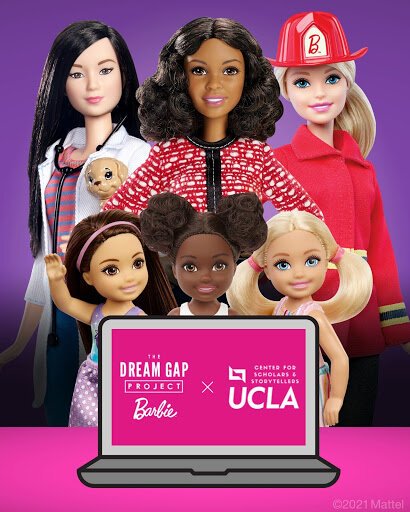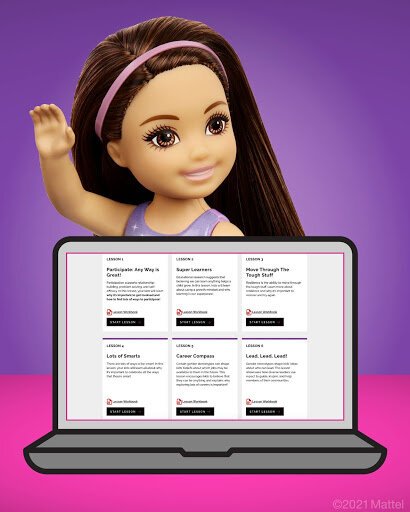From Limiting Beliefs to Limitless Potential: How Mister Rogers and Barbie Inspired My Learning Design of a Multimedia Curriculum for Young Children
It was never my intention to pull a Mister Rogers.
Then again — was it?
As a children’s media researcher and learning designer, I’m keenly aware of Mister Rogers’ Neighborhood’s pedagogical punch. In fact, I dedicate an entire class session to this show and its spin-off, Daniel Tiger’s Neighborhood, in the course I teach on youth and media at the USC Annenberg School for Communication and Journalism.
When media are crafted sensitively, designed to meet children where they’re at and loaded with meaningful lessons, then young children can demonstrate significant learning outcomes.
Maybe this was in the back of my head when my colleagues at the Center for Scholars & Storytellers and I accepted an important challenge…
Context
Barbie, a brand first-famous for inventing 11.5-inch fashion dolls, has evolved into a cultural icon, and after 60+ years, was still the number one toy property in the world in 2020. Over the years, Barbie has had over 200 careers, nine body types, 35 skin tones, and 94 hairstyles. The brand’s slogan proudly declares: You Can Be Anything.
So, when a team of NYU researchers published data suggesting that some young children can’t be anything, and implicated stereotypes as a major reason why, Barbie took notice. The research found that, by the age of 6, many children begin to embrace limiting beliefs, specifically:
Girls stop believing that they are as smart as boys
Boys stop believing that they are as kind as girls
Girls avoid demonstrating their leadership skills
Girls and boys doubt that girls can be anything
Internalizing these beliefs can lead children to marginalize themselves and others. And there goes everyone’s chance to be anything.
Barbie labeled the space between children’s limitless potential and their limiting beliefs “The Dream Gap.” And to help close it, Barbie funds partner organizations impacting girls directly, inspires girls through meaningful content, highlights inspirational women through their role models program, and now has commissioned a stereotype-defying curriculum.
That’s where we came in.
Barbie Dream Gap Curriculum — The Original
My colleagues and I designed the Barbie Dream Gap Curriculum by working backward. Our goal was to disrupt young children’s trajectories towards both stereotyping others by gender and denying themselves the opportunity to be their whole selves. Which “tools” would young children need in their “toolboxes” in order to get there?
First, we reasoned, they would need to feel empowered to authentically contribute. Lesson 1: Participation. Second, they would need to believe in their ability to learn and improve through effort. Lesson 2: Growth Mindset. Third, they would need to expect challenges and recover from setbacks. Lesson 3: Resilience. Fourth, they would need to celebrate their unique talents and interests. Lesson 4: Multiple Intelligences. Fifth, they would need to picture themselves in numerous and stereotype-defying occupations. Lesson 5: Careers. Sixth, they would need to step into their power. Lesson 6: Leadership.
To explicitly push back against harmful stereotypes, not only pertaining to gender but also to race/ethnicity, class, nationality, and ability, we incorporated the stories of diverse role models, including: Jovita Idár, Helen Keller, Junko Tabei, Fred Rogers, Maggie Lena Walker, and Annie Dodge Wauneka.
Our curriculum organically intersected with multiple social and emotional learning (SEL) goals. Research shows that universal, school-based SEL programs benefit K-12 students across a variety of measures in the short- and long-term. So, we aligned our curriculum to SEL standards.
We formatted the curriculum as a K-2 teacher-facing collection of lesson plans, worksheets, and newsletters, with an original, live-action video and a poster accompanying each lesson.
In our 2019 pilot in El Segundo, California, the curriculum demonstrated promising results. Independent evaluators conducted a classic experiment, collecting pre- and post-test data from intervention and control groups. Findings showed that the curriculum:
Expanded children’s interest in more careers
Increased all girls’ beliefs that anyone could be a good leader
Inspired more 2nd grade girls to identify females as “really really smart” and to say YES to the question, “Do you think you can be anything?”
To say I was excited would be putting it mildly. First, El Segundo. Next, the world!
Then a little something unexpected happened in 2020... Perhaps you can recall…
Barbie Dream Gap Curriculum — Take Two
Barbie challenged us to adapt the curriculum for online learning. In digital form, the lessons could reach remote and hybrid learners as well as support diverse educators.
We reimagined our curriculum as a video series featuring Community Club, an after-school club whose members yearn to help people and animals and fix things in their communities. Community Club meets online, via a video conferencing platform like Zoom -- and the students viewing the content just stumbled into its meeting. Welcome to Community Club! We split each lesson (aka, each Community Club meeting) across three videos, separated by two interactive opportunities where students could answer a question by clicking on an icon.
Channeling my inner Rogers, I played Dr. Rachel Klein, the club’s warm-and-fuzzy advisor. In that role, I facilitated many of the same activities as our original lesson plans. I also created three characters to populate Community Club’s membership:
Jada, an inquisitive, independent third-grader who identifies as a Chinese-American girl and manages anxiety;
Lulu, a thoughtful, methodical third-grader who identifies as a Black girl and as “quiet,” or introverted; and
Mateo, a gentle, collaborative third-grader who identifies as a Mexican-American boy and lives with hearing loss.
These characters were brought to life by bespoke hand and rod puppets, each operated by a puppeteer and separately voiced by an actor whose identity matched that of the character.
Educators and students nationwide piloted the curriculum this spring — thank you to participating schools in Boston, Chicago, and Austin! So far, we’ve gotten lots of positive feedback.
“I felt that the lesson was well thought out and kid friendly.”
“Loved the video with the student leader. It is so helpful for students to see the ideas in action. Also, really wonderful for them to see themselves reflected in the people in the video.”
“It was very beneficial how the puppets shared how they cope with differences, hearing loss and anxious thoughts.”
We will continue piloting the curriculum this summer — thank you to participating after-school organizations in South Carolina! — and in the fall. We look forward to combing through the data and discovering whether/how this multimedia experience serves children.
As to bridging The Dream Gap… Mr. Rogers once said, “There's a world of difference between insisting on someone's doing something and establishing an atmosphere in which that person can grow into wanting to do it.”
So, our work does not end at curriculum. Here’s to all of us, in our own unique ways, establishing an atmosphere, a society, a world that inspires everyone to want to unlock opportunity — so our kids can be anything.
Principal, Laurel Felt Consulting
Lecturer, USC Annenberg School for Communication and Journalism
Senior Fellow, Center for Scholars and Storytellers
P.S. This project was a labor of love for so many people!!! To quote Fred Rogers, “I hope you're proud of yourself for the times you've said "yes," when all it meant was extra work for you and was seemingly helpful only to someone else." I am beyond grateful and humbled by your brilliance.
THANK YOU:
Maggie Chieffo, Yalda T. Uhls, Hannah Demetor, Kathryn Lenihan, Kim Wilson, Colleen Russo Johnson, Josanne Buchanan, Rosie Molinary, Mary Faber, Benari Poulten, Hand to Mouth Creative, Jenn Guptill, Katie O’Brien, Jaz Nannini, Students of Spring 2021 COMM 457, Sarah Berman, Chris Patstone, Miles Taber, Karen Barazza, Jenny W. Chan, Whitney Watters, Adam Blau, Gaby Moreno, Deborah S. Craig, Rebecca Naomi Jones, Nir Liebenthal, Page Spencer, Caroline Fung, Annie Meyers, Zach Stuckelman, Sina Zakeri, Anita Narkhede, Arelyse Campos, Rebeca Ruiz, Tina Garoosi, Gillian Jewell, Jill Shinderman, Kat O’Brien, Corinne, Everett, Mike Colby, Sasha, Andrea Merfeld, Lexi, Randi Ralph, Molly, Annie, Cyndi Otteson, Quinn, Ellie Chadwick, Richie, Kimmi Berlin, Ari, Diomaris Safi, Mila, Miry Whitehill, Ruben, Rebecca Fox, Ruthie, Muriel, Gardenia Spiegel, Koa, Rachel Deano, Jada.








